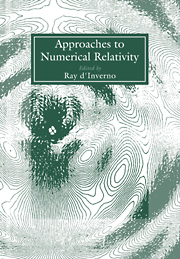Book contents
- Frontmatter
- Contents
- Contributors
- Introduction
- Preface
- PART A THEORETICAL APPROACHES
- Numerical relativity on a transputer array
- Some aspects of the characteristic initial value problem in numerical relativity
- The characteristic initial value problem in general relativity
- Algebraic approach to the characteristic initial value problem in general relativity
- On hyperboloidal hypersurfaces
- The initial value problem on null cones
- Introduction to dual-null dynamics
- On colliding plane wave space-times
- Boundary conditions for the momentum constraint
- On the choice of matter model in general relativity
- A mathematical approach to numerical relativity
- Making sense of the effects of rotation in general relativity
- Stability of charged boson stars and catastrophe theory
- PART B PRACTICAL APPROACHES
- PANEL DISCUSSION
Introduction to dual-null dynamics
Published online by Cambridge University Press: 15 December 2009
- Frontmatter
- Contents
- Contributors
- Introduction
- Preface
- PART A THEORETICAL APPROACHES
- Numerical relativity on a transputer array
- Some aspects of the characteristic initial value problem in numerical relativity
- The characteristic initial value problem in general relativity
- Algebraic approach to the characteristic initial value problem in general relativity
- On hyperboloidal hypersurfaces
- The initial value problem on null cones
- Introduction to dual-null dynamics
- On colliding plane wave space-times
- Boundary conditions for the momentum constraint
- On the choice of matter model in general relativity
- A mathematical approach to numerical relativity
- Making sense of the effects of rotation in general relativity
- Stability of charged boson stars and catastrophe theory
- PART B PRACTICAL APPROACHES
- PANEL DISCUSSION
Summary
Abstract. Much of physics concerns temporal dynamics, which describes a spatial world (or Cauchy surface) evolving in time. In Relativity, the causal structure suggests that null dynamics is more relevant. This article sketches Lagrangian and Hamiltonian formalisms for dual-null dynamics, which describes the evolution of initial data prescribed on two intersecting null surfaces. The application to the Einstein gravitational field yields variables with recognisable geometrical meaning, initial data which divide naturally into gravitational and coordinate parts, and evolution equations which are covariant on the intersection surface and free of constraints.
INTRODUCTION
The ADM or “3+1” formalism [1,2] is a natural approach to the Cauchy problem in General Relativity, and has been used widely both analytically and numerically. By comparison, null (or characteristic) evolution problems are more appropriate to the study of problems involving radiation, whether gravitational or otherwise, since radiation propagates in null directions. Null surfaces also have a central place in the causal structure of General Relativity which spatial surfaces do not.
A distinction should be drawn between the null-cone problem discussed elsewhere in this volume, in which the initial surface is a null cone, and the dual-null problem, in which there are two intersecting null initial surfaces. The latter problem was originally described by Sachs [3], with existence and uniqueness proofs being given by Müller zum Hagen and Seifert [4], Friedrich [5] and Rendall [6], and a general “2+2” formalism being developed by d'Inverno, Smallwood and Stachel [7–9].
Information
- Type
- Chapter
- Information
- Approaches to Numerical Relativity , pp. 69 - 78Publisher: Cambridge University PressPrint publication year: 1992
